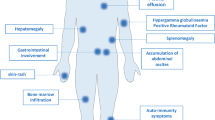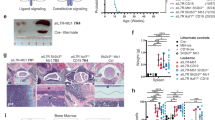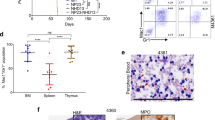Abstract
Mer (MerTK) is a receptor tyrosine kinase important in platelet aggregation, as well as macrophage cytokine secretion and clearance of apoptotic cells. Mer is not normally expressed in thymocytes or lymphocytes; however, ectopic Mer RNA transcript and protein expression is found in a subset of acute lymphoblastic leukemia cell lines and patient samples, suggesting a role in leukemogenesis. To investigate the oncogenic potential of Mer in vivo, we created a transgenic mouse line (MerTg) that expresses Mer in the hematopoietic lineage under control of the Vav promoter. Ectopic expression and activation of the transgenic Mer protein was demonstrated in lymphocytes and thymocytes of the MerTg mice. At 12–24 months of age, greater than 55% of the MerTg mice, compared to 12% of the wild type, developed adenopathy, hepatosplenomegaly, and circulating lymphoblasts. Histopathological analysis and flow cytometry were consistent with T-cell lymphoblastic leukemia/lymphoma. Mer may contribute to leukemogenesis by activation of Akt and ERK1/2 anti-apoptotic signals, which were upregulated in MerTg mice. Additionally, a significant survival advantage was noted in MerTg lymphocytes compared to wild-type lymphocytes after dexamethasone treatment. These data suggest that Mer plays a cooperative role in leukemogenesis and may be an effective target for biologically based leukemia/lymphoma therapy.
This is a preview of subscription content, access via your institution
Access options
Subscribe to this journal
Receive 50 print issues and online access
$259.00 per year
only $5.18 per issue
Buy this article
- Purchase on Springer Link
- Instant access to full article PDF
Prices may be subject to local taxes which are calculated during checkout






Similar content being viewed by others
References
Adams JM, Harris AW, Strasser A, Ogilvy S, Cory S . (1999). Oncogene 18: 5268–5277.
Anderson KE, Jackson SP . (2003). Int J Biochem Cell Biol 35: 1028–1033.
Behrens EM, Gadue P, Gong SY, Garrett S, Stein PL, Cohen PL . (2003). Eur J Immunol 33: 2160–2167.
Blume-Jensen P, Hunter T . (2001). Nature 411: 355–365.
Borgel D, Clauser S, Bornstain C, Bieche I, Bissery A, Remones V et al. (2006). Crit Care Med 34: 219–222.
Chen J, Carey K, Godowski PJ . (1997). Oncogene 14: 2033–2039.
Curran-Everett D . (2000). Am J Physiol Regul Integr Comp Physiol 279: R1–R8.
Dirks W, Rome D, Ringel F, Jager K, MacLeod RA, Drexler HG . (1999). Leuk Res 23: 643–651.
Dormady SP, Zhang XM, Basch RS . (2000). Proc Natl Acad Sci USA 97: 12260–12265.
Druker BJ, Tamura S, Buchdunger E, Ohno S, Segal GM, Fanning S et al. (1996). Nat Med 2: 561–566.
Egle A, Harris AW, Bouillet P, Cory S . (2004). Proc Natl Acad Sci USA 101: 6164–6169.
Eischen CM, Weber JD, Roussel MF, Sherr CJ, Cleveland JL . (1999). Genes Dev 13: 2658–2669.
Ek S, Hogerkorp CM, Dictor M, Ehinger M, Borrebaeck CA . (2002). Cancer Res 62: 4398–4405.
Evans CO, Young AN, Brown MR, Brat DJ, Parks JS, Neish AS et al. (2001). J Clin Endocrinol Metab 86: 3097–3107.
Ferrando AA, Neuberg DS, Staunton J, Loh ML, Huard C, Raimondi SC et al. (2002). Cancer Cell 1: 75–87.
Georgescu MM, Kirsch KH, Shishido T, Zong C, Hanafusa H . (1999). Mol Cell Biol 19: 1171–1181.
Gilliland DG, Griffin JD . (2002). Blood 100: 1532–1542.
Graham DK, Bowman GW, Dawson TL, Stanford WL, Earp HS, Snodgrass HR . (1995). Oncogene 10: 2349–2359.
Graham DK, Dawson TL, Mullaney DL, Snodgrass HR, Earp HS . (1994). Cell Growth Differ 5: 647–657.
Graham DK, Salzberg DB, Kurtzberg J, Sather S, Matsushima GK, Keating AK et al. (2006). Clin Cancer Res 12 (in press).
Graham FL, Smiley J, Russell WC, Nairn R . (1977). J Gen Virol 36: 59–74.
Grandage VL, Gale RE, Linch DC, Khwaja A . (2005). Leukemia 19: 586–594.
Graux C, Cools J, Melotte C, Quentmeier H, Ferrando A, Levine R et al. (2004). Nat Genet 36: 1084–1089.
Guttridge KL, Luft JC, Dawson TL, Kozlowska E, Mahajan NP, Varnum B et al. (2002). J Biol Chem 277: 24057–24066.
Hanahan D, Weinberg RA . (2000). Cell 100: 57–70.
Harris AW, Pinkert CA, Crawford M, Langdon WY, Brinster RL, Adams JM . (1988). J Exp Med 167: 353–371.
Heisterkamp N, Jenster G, ten Hoeve J, Zovich D, Pattengale PK, Groffen J . (1990). Nature 344: 251–253.
Henze G, Fengler R, Hartmann R, Kornhuber B, Janka-Schaub G, Niethammer D et al. (1991). Blood 78: 1166–1172.
Jia R, Hanafusa H . (1994). J Biol Chem 269: 1839–1844.
Jia R, Mayer BJ, Hanafusa T, Hanafusa H . (1992). J Virol 66: 5975–5987.
Khan J, Bittner ML, Saal LH, Teichmann U, Azorsa DO, Gooden GC et al. (1999). Proc Natl Acad Sci USA 96: 13264–13269.
Krause DS, Van Etten RA . (2005). N Engl J Med 353: 172–187.
Ling L, Kung HJ . (1995). Mol Cell Biol 15: 6582–6592.
Naf D, Krupke DM, Sundberg JP, Eppig JT, Bult CJ . (2002). Cancer Res 62: 1235–1240.
Ogilvy S, Metcalf D, Gibson L, Bath ML, Harris AW, Adams JM . (1999). Blood 94: 1855–1863.
Pui CH, Evans WE . (1998). N Engl J Med 339: 605–615.
Pui CH, Relling MV, Downing JR . (2004). N Engl J Med 350: 1535–1548.
Reed JC . (1999). J Clin Oncol 17: 2941–2953.
Sattler M, Salgia R . (2004). Leuk Res 28 (Suppl 1): S11–S20.
Savage DG, Antman KH . (2002). N Engl J Med 346: 683–693.
Schlessinger J . (2000). Cell 103: 211–225.
Schrappe M, Camitta B, Pui CH, Eden T, Gaynon P, Gustafsson G et al. (2000). Leukemia 14: 2193–2194.
Silverman LB, Gelber RD, Dalton VK, Asselin BL, Barr RD, Clavell LA et al. (2001). Blood 97: 1211–1218.
Strasser A, Harris AW, Bath ML, Cory S . (1990). Nature 348: 331–333.
Tibes R, Trent J, Kurzrock R . (2005). Annu Rev Pharmacol Toxicol 45: 357–384.
Vivanco I, Sawyers CL . (2002). Nat Rev Cancer 2: 489–501.
Wolfraim LA, Fernandez TM, Mamura M, Fuller WL, Kumar R, Cole DE et al. (2004). N Engl J Med 351: 552–559.
Wu CW, Li AF, Chi CW, Lai CH, Huang CL, Lo SS et al. (2002). Anticancer Res 22: 1071–1078.
Yeoh EJ, Ross ME, Shurtleff SA, Williams WK, Patel D, Mahfouz R et al. (2002). Cancer Cell 1: 133–143.
Acknowledgements
We acknowledge Karen Helm and the University of Colorado Flow Cytometry Core for their expertise and assistance. Grant support: DBS is supported by the Schow Research Fellowship from the National Childhood Cancer Foundation. DBS and AKK are supported by the NIH training grant T32CA86068604. DKG is supported by the V Foundation for Cancer Research and The Children's Hospital Research Institute (Denver, CO).
Author information
Authors and Affiliations
Corresponding author
Rights and permissions
About this article
Cite this article
Keating, A., Salzberg, D., Sather, S. et al. Lymphoblastic leukemia/lymphoma in mice overexpressing the Mer (MerTK) receptor tyrosine kinase. Oncogene 25, 6092–6100 (2006). https://doi.org/10.1038/sj.onc.1209633
Received:
Revised:
Accepted:
Published:
Issue Date:
DOI: https://doi.org/10.1038/sj.onc.1209633
Keywords
This article is cited by
-
TAM family kinases as therapeutic targets at the interface of cancer and immunity
Nature Reviews Clinical Oncology (2023)
-
TAM-ing T cells in the tumor microenvironment: implications for TAM receptor targeting
Cancer Immunology, Immunotherapy (2020)
-
Irf8 regulates the progression of myeloproliferative neoplasm-like syndrome via Mertk signaling in zebrafish
Leukemia (2018)
-
Efferocytosis in the tumor microenvironment
Seminars in Immunopathology (2018)
-
Determination of structural requirements of Mer kinase inhibitors and binding interaction analysis using in silico approaches
Medicinal Chemistry Research (2016)



